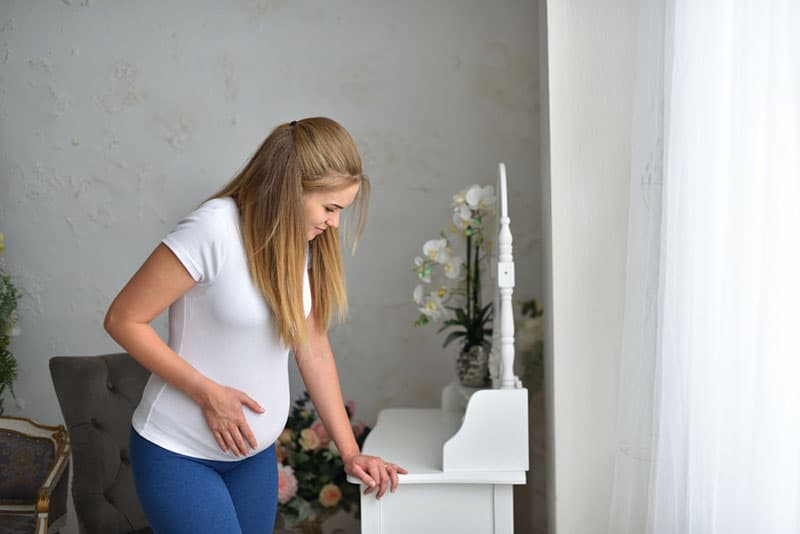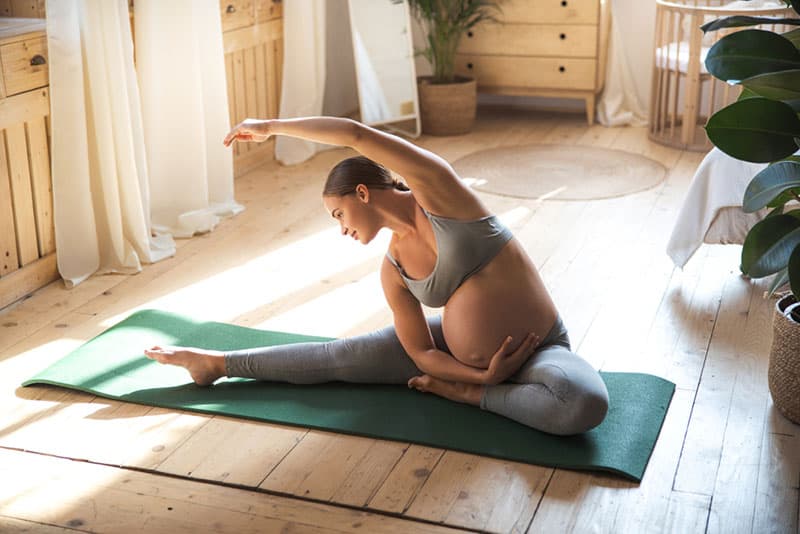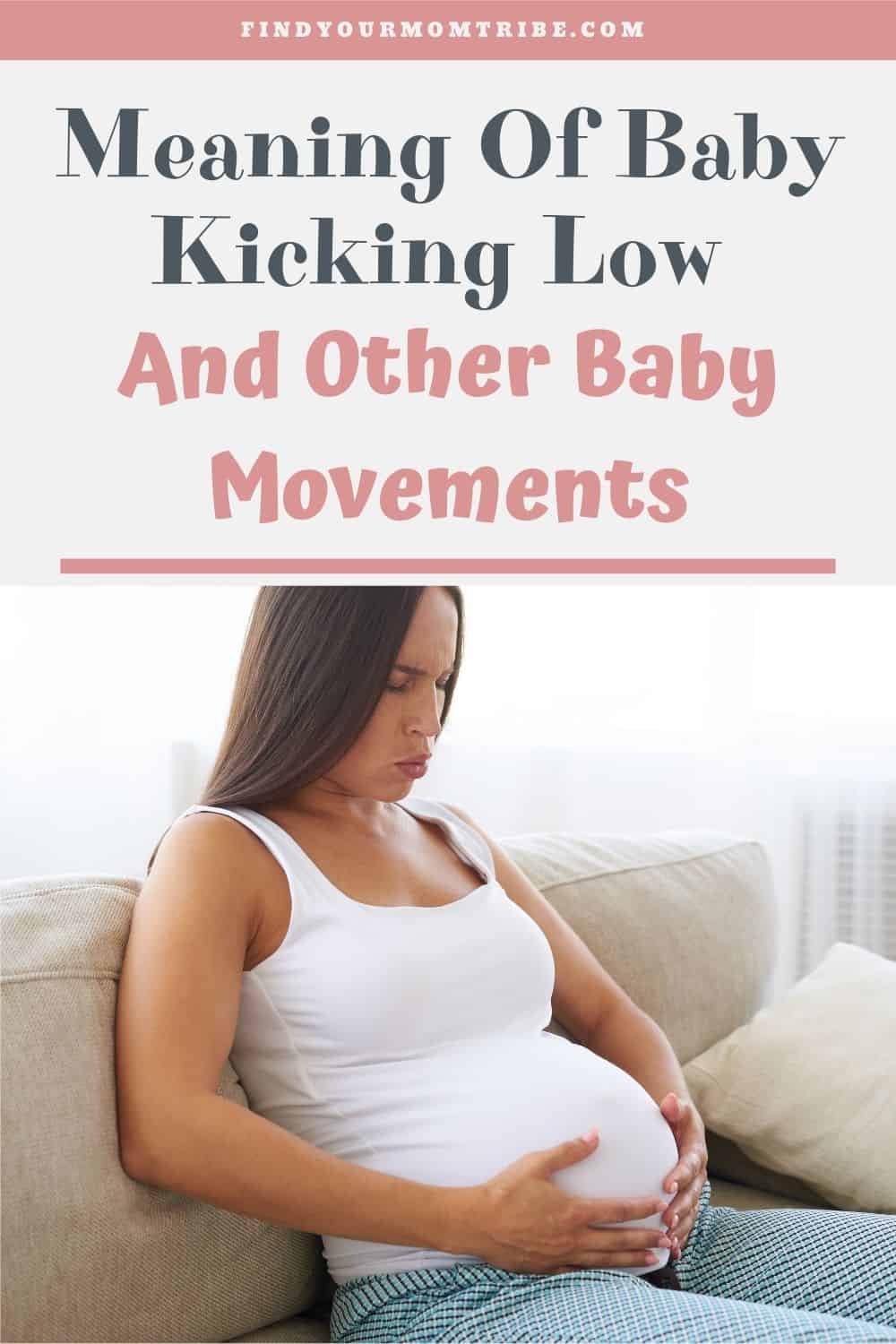Without a doubt, feeling your baby’s movements in your belly is one of the most wondrous sensations you could ever experience.
But sometimes these kicks are a cause for concern, too. For example, is your baby kicking low?
When a baby is kicking low, it’s an indication that he is in a bottom-first position, and his legs are able to jab at the lower part of your belly.
This indicates that the baby is breech – at least for the time being. The good news is that most breech babies turn before the contractions kick in, so it doesn’t automatically mean you’ll need to be scheduled for a C-section.
Your doctor can also perform a simple procedure to help your baby turn, called an external cephalic version (ECV). But a lot of breech babies adjust their position while you’re sleeping.
Apart from the baby kicking low, there are other types of movements an expecting mama should familiarize herself with.
For example, did you know that babies can hiccup? And that you can feel this in the form of a twitching sensation?
Although doctors aren’t sure what causes fetal hiccuping, it may be linked to the baby’s lung development.
Your baby will also roll and stretch in your belly to make himself as comfortable as possible until it’s time for the big day.
Sometimes his aerobics will be borderline painful, but as long as the pain is temporary, you have nothing to worry about.
Baby Kicking Low – What Does It Mean?

Is your baby kicking low? There’s a fairly simple explanation for this phenomenon.
As mentioned earlier, when your baby kicks low, it’s possible that he is in a breech position, meaning that he is in a bottom-first, instead of a head-first position.
In a complete breech, the baby will sit in a cross-legged position, making it easy to deliver those low kicks. A breech baby can also kick your cervix.
Your healthcare provider will be able to confirm your baby’s position, but even if your baby is breech, don’t automatically assume you’ll need to have a C-section .
In fact, most babies turn into a head-down position before your due date and only a small percentage remains in a bottom-first position by the time you’re supposed to give birth.
There are many exercises for pregnant women aimed at helping their baby turn, but your unborn baby might turn on his own – it’s possible that you might not even realize that it has happened.
One of the exercises you can try is a simple bridge pose. Lie on the floor and bend your legs so that your feet are positioned under your knees.
Then, lift the lower part of your body into a bridge pose and hold it for as long as you can – preferably at least 10 minutes.
If you can’t make it in one go, then take a break and come back to the pose when you’re ready.
Another pose, called a forward-leaning inversion, involves sitting down on the couch with your knees tucked under, then leaning over so that your elbows are on the floor.
For the safety of you and your baby, have someone by your side who can help.
You can also get on your hands and knees and move in a rocking motion forward and backward. These exercises are best done when your baby is already moving around and active.
If the baby doesn’t turn on his own, you might be offered an external cephalic version (ECV) – a simple procedure during which your doctor puts pressure on your stomach to motivate your little one to move into a head-down position.
If you were wondering Why is my baby kicking so low? now you know that it’s likely related to the baby’s position in utero.
But fear not – there’s a high chance he will turn before it’s time to give birth.
Types Of Baby Kicks And Movements
Apart from your baby kicking low, there are other kinds of movements you might experience at different stages of your pregnancy.
1. Quickening

Quickening refers to the very first movements of your baby in utero.
It’s very subtle and feels like gentle fluttering in your stomach, which is why it’s difficult to know whether it’s your baby or just your digestive system.
According to the American Pregnancy Association, it’s possible for a woman to start feeling quickening 13 to 16 weeks after the beginning of their last menstrual cycle.
A woman who has given birth before is likely to feel these flutters sooner than a woman who is pregnant for the very first time.
In the latter case, it’s possible for you not to feel any movement up to 20 weeks of pregnancy.
If you’re eager to feel those first flutters, you can try lying on your left side, which is better for your circulation. Relax and focus on feeling any movements in your belly.
Not all women experience quickening as fluttering – it’s possible that you might feel a tickling sensation or something similar to bubbles.
2. Hiccups

Yes, even babies who are in utero can get hiccups! However, it’s not always easy to tell whether your baby is hiccuping or just moving around.
Usually, hiccups feel rhythmic, like a twitching sensation in your stomach similar to a muscle spasm.
It’s not certain why babies hiccup in the womb – some experts connect this phenomenon to the development of lungs. And it’s entirely possible that you won’t feel them at all.
But most moms-to-be start feeling their baby hiccuping in the second and third trimester.
One way of distinguishing hiccups from regular jabs and kicks is to pay attention to when and where you experience these sensations.
If you feel a pulsing and twitching sensation in just one part of your stomach when you’re resting, then it’s probably hiccups.
But if you feel movement in different areas of your stomach, especially after you’ve just eaten or had a cold drink, then it’s probably just your baby readjusting his position in utero.
3. Taps

Before your little one gets strong enough to make his presence in your belly well-known, you might feel a sensation similar to a soft tapping on the inside of your belly.
Since your baby still isn’t developed enough for you to feel stronger movement through the uterine wall and all the other layers that keep the baby safe and protected, these kicks still feel quite gentle.
But don’t worry, they’ll increase in intensity sooner or later!
4. Kicks

As your little munchkin grows, he’ll want to move around and stretch more.
Things are getting pretty cramped in there and he’s slowly running out of room, so you’ll be able to feel those kicks more strongly than before.
Although it’s exciting to feel your baby move, these sensations can be accompanied by discomfort, especially when your baby delivers a kick to a particularly uncomfortable spot.
You’ll also notice your baby seems to be more active after you eat certain foods, such as a spicy burrito or a delicious brownie .
Many pregnant women notice that their little munchkin is much more active at night just as they go to bed, making it much harder to get a good night’s sleep.
One of the possible reasons behind this is that babies might find the mother’s daily movements soothing and they rock them to sleep.
So, once the mother settles down and the rocking sensations stop, the baby wakes up and starts moving around.
Many parents take this as a warning sign that their baby will prefer to be awake during the night time after he’s born, but you shouldn’t be concerned about this during your pregnancy – there’s plenty of time for your baby to develop his sleeping patterns once he’s out in the world!
5. Rolling

As you enter your third trimester, your baby is slowly running out of room inside your belly. Now, your baby is strong enough for you to actually see his movements.
You’ll be able to feel your baby rolling in utero and see it, too – it might resemble a tiny wave or ripple.
This is a great time for your partner (and older siblings, if there are any) to bond with the baby and get excited about the upcoming birth.
You might even see a handprint or a footprint appear!
6. Pelvic pressure

As you get closer to your due date, it’s normal for babies to get into a head-down position and for their head to move down into the pelvis.
In other words, this is when the baby is engaged in pelvis, a position that puts significant pressure on the area below the belly button.
When your baby engages, the appearance of your baby bump will change (it will hang lower than usual) and you’ll be taking more trips to the bathroom as your little bundle will be applying more pressure on your bladder.
But there’s an upside to this movement, as you’re less likely to experience heartburn and you can eat bigger meals. You’ll also be able to breathe more fully.
It’s important to note that when your baby gets bigger, he’ll have less space to kick and jab, but he will still stretch and move around.
When Will I Start Feeling My Baby’s Movements?

Feeling your baby’s kicks for the first time is an exciting moment for every new mom, especially if this is your first pregnancy.
Your baby is making his presence known and every little jab is a reminder that you’re no longer alone. So when can you expect your baby to move?
During your first trimester, you’ll be experiencing all the uncomfortable pregnancy symptoms, such as nausea, morning sickness, and feeling tired all the time.
You’ll be able to feel your baby move from your second trimester, starting usually between 18 and 22 weeks of pregnancy.
If this is your first baby, it might take a while for you to recognize fetal movement – many first-time moms mistake it for gas in the beginning, before the baby starts getting stronger and the movement becomes more pronounced.
If this isn’t your first pregnancy, however, you’ll likely feel movement sooner rather than later, as you’ll be familiar with the sensation.
But this is not the only factor that can affect when you’ll start feeling your baby move. How your placenta is positioned plays an important role, too.
Women who have an anterior placenta, meaning that the placenta is at the front of your uterus, might not feel their babies move as strongly.
It’s important for you not to compare your experience to those of other pregnant women as each pregnancy is unique.
Take any concerns up with your OB-GYN and familiarize yourself with the pattern of movements specific to your baby so that you can catch any changes in time.
Is It Normal To Feel Pain When The Baby Kicks?

Once your baby starts moving in earnest and becomes very active, it’s perfectly normal to feel discomfort or even pain when the baby is on the move.
For example, you might feel pain in the stomach, or in the rib or vaginal area – depending on where the baby was kicking.
The pain can be very sharp, but it should go away once your baby stops moving. If the painful sensation persists, then you should get in touch with your doctor to check on your baby’s wellbeing.
It’s also possible for the baby to spend a while in one position, causing that area of your belly to get very uncomfortable or even sore.
Whenever this happens, try changing your position if you’re sitting or lying down to encourage your baby to also move.
Should I Keep A Kick Count?

When you’re carrying a baby, his movements are what lets you know he’s okay – not feeling them for a while or noticing something has changed in the regular pattern of movement is enough to cause any woman to worry.
That’s why it’s recommended to familiarize yourself with how much your baby moves instead of comparing yourself to other pregnant women, as some babies are more active than others.
So, when should you start counting kicks? You can start once you enter your third trimester or around week 28 of your pregnancy.
You can simply write them down on a piece of paper, but there are smartphone apps to help you track them too.
Pick a time of day when you’re usually free to sit and relax, and count the amount of time it took your baby to make 10 movements.
Repeat this for a few days in a row and you will determine the average amount of time your baby needs to move at least 10 times.
If you don’t have a high-risk pregnancy, there’s no need to worry if you skip a day of counting.
For some women who suffer from anxiety, the pressure of counting kicks can only make them more stressed out, so try not to fall down the rabbit hole of obsessing over your baby’s kicks.
It might take your baby half an hour or an hour to make 10 movements, so if you notice a drastic change from your baby’s normal activity level, you might want to get in touch with your doctor.
You can also call your healthcare provider if you haven’t been able to record 10 movements in 2 hours.
Can The Baby’s Movements Predict Childhood Behavior?

It’s very common to hear that a baby who likes to go crazy in utero will have you running all over the place as soon as he learns how to crawl.
Apparently, there could be a connection between the amount of fetal movements and the energy levels of a child.
Although this might sound like an old wives’ tale, scientists have tried to determine whether there is a link between fetal movements and how active a child is later on.
A study by Janet DiPietro et al. (2002) attempted to find any links between fetal movement and the behavior during the first 2 years of a baby’s life.
The results were interesting – male fetuses that had high activity levels at 36 weeks of gestation were more active babies and toddlers.
But when it came to girls, the results were opposite.
But no matter whether they were male or female, babies that were more active in utero had bigger chances of communicating with strangers or interacting with toys at 24 months of age.
So, it seems like you have lots to look forward to if you’re carrying a very active baby boy!
But considering that the study was conducted with only 52 babies, it’s always possible that your child will be an exception.
Furthermore, Degani et al. (2009) in a study tried to establish links between fetal movement of twins and their temperament as infants.
Moms reported that the baby that was more active during ultrasound appointments was more active and less predictable at 3 and 6 months of age.
Ways To Get Your Baby To Move In The Womb
If you feel like your baby is less active than usual, don’t panic! There are plenty of ways to encourage your baby to move in utero – and they’re quite pleasant, too.
1. Lie down

Or even better – get in the bath. Chances are that your baby was sleeping all day while you were up on your feet, running errands, and being busy.
All of that movement, while exhausting for you, is super relaxing for your little one, so he might have been asleep and not had time to kick and move.
But when you lie down, the change of pace should hopefully rouse your baby from his sleep and encourage him to move.
If you’re in the bath, you might even see the water ripple as your little munchkin moves.
Alternatively, you can lie down and put a remote control on the top of your stomach so that you don’t miss any activity.
2. Chow down

It’s no surprise that babies are usually most active after you have a meal. Food increases your blood sugar levels, giving both you and your baby more energy to seize the day.
Some pregnant women love spicy food and find that it makes their baby extra active, but unless you eat spicy food on a regular basis, you probably shouldn’t start while you’re pregnant for the sake of your digestive system.
Other than that, there are no other dangers associated with eating hot food while you’re pregnant.
Spicy noodles will not send you into early labor – this is just an old wives’ tale!
If you’re up for a sweet snack, have a cookie or two to raise your blood sugar – it will do the same trick, Just don’t overdo it.
Fruits are a healthier alternative, so you can have a banana or a handful of grapes if you’d like to avoid the typical chocolate or sweets.
3. Have a cold drink

If you’re in a rush and don’t have the time to cook a full-blown meal, just grab a cold drink of water or juice (orange juice is a favorite of expecting mothers) and wait for the effects to kick in.
A cold drink is effective because of the low temperature, which causes the baby to stir, but if you have juice instead of water, the sugar in the drink will energize your baby.
Smoothies and shakes will have a similar effect as well.
4. Start moving

You don’t need to get into a full-blown exercise routine or yoga session to temporarily increase your blood pressure and cause more of your baby’s movements.
Go up and down the stairs several times or do a few jumping jacks – this should be more than enough!
If your baby had been sleeping, such activity is guaranteed to wake him up.
5. Try music and lights

From week 16 of your pregnancy, your baby will be able to recognize lights and might even respond to them!
Try shining a bright light on your belly bump and see if he objects to the sudden brightness with a jab or a kick.
The same goes for music! Babies usually begin to hear sounds after you enter the second trimester, but aren’t likely to let you know that they can hear the music you’re playing or that you’re talking to them until the third trimester.
In addition to playing music, you can sing or just talk to your belly and wait for your little one to respond.
6. Get your adrenaline pumping

An effective way of rousing your baby from his sleep is to find a way to get your adrenaline pumping (without putting your life in danger, of course).
One of the quickest ways of doing this is to watch a movie – thrillers and action movies will have you sitting on the edge of your seat – and energize your baby too!
Final Thoughts
Is your baby kicking low? That’s probably because he is currently in a breech position that allows his feet to kick at the lower part of your belly.
Don’t worry as there is plenty of time for your baby to turn and get into a head-first position for birth. In the meantime, make sure to go to all of your antenatal appointments and ask any and all questions that cross your mind.
References:
- DiPietro, J. A., Bornstein, M. H., Costigan, K. A., Pressman, E. K., Hahn, C. S., Painter, K., Smith, B. A., & Yi, L. J. (2002). “What does fetal movement predict about behavior during the first two years of life? Developmental Psychobiology: The Journal of the International Society for Developmental Psychobiology”, 40(4), 358-371.
- Degani, S., Leibovitz, Z., Shapiro, I., & Ohel, G. (2009). “Twins’ temperament: early prenatal sonographic assessment and postnatal correlation. Journal of Perinatology”, 29(5), 337-342.
- American Pregnancy Association. (2019, April 25). “First fetal movement: Quickening [Blog post]”. Retrieved from the American Pregnancy Association website.
Like this post? Please share or pin it for later. You can also stay in the loop and follow us on Facebook, Instagram or Pinterest.

This post contains affiliate links. Please see our full disclosure for more info.

